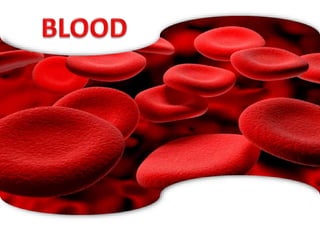
bloodanatomy-161209030356.pptx
- 2. Blood The circulating fluid including plasma and different cells such as red blood cells, white blood cells and platelets in the vascular system of humans and other Vertebrates.
- 3. Functions of blood • Supplies essential nutrients in cells such as glucose, fatty acid and amino acids. • Transport oxygen O2 and carbon dioxide CO2, and hormones in the body. • Protects from pathogens, blood loss and diseases. • Helps regulate body temperature.
- 4. Physical characteristics • More viscous(thick) than water. • 100.4 degree F temperature. • 8% of total body weight. • Average blood volume in males is 5-6 liters. • And 4-5 liters in average female.
- 6. Components of blood Blood is made up of two main components. • Blood cells • Plasma (45%) (55%)
- 7. Blood cells Three types of blood cells are • Red blood cells • White blood cells • Platelets (erythrocytes) (leucocytes) (thrombocytes)
- 9. Red blood cells • Also called erythrocytes • Biconcave shape • Elastic cell membrane • No nucleus • 95% of the RBC consist of hemoglobin(red pigment) • Remaining 5% consist of enzymes, salts and other protein
- 10. Continued red blood cells • Formed in red bone marrow • Average life is four months • About 2-10 million red blood cells are formed and destroyed in every second. • The main function of the RBC is to transport oxygen and carbon dioxide. • Blood of male contains 5-5.5 million RBC per cubic millimeter. • Blood of female contains 4-4.5 million RBC per cubic millimeter.
- 11. White blood cells • Also called as leucocytes • They are colorless • Much larger than red blood cells • One cubic millimeter of blood contains 7000 to 8000 WBC • Formed in bone marrow • Their life span depends on the body need so they have life span of months or even years
- 12. Continued white blood cells • white blood cells are about 1% in healthy people. • Only 2% of total WBC population circulating in blood at a time - Rest is in the skin, lungs and spleen. Main function These are the cells of the immune system that are involved in protecting the body against both infectious disease and foreign invaders.
- 13. Types of WBC • Granulocytes These WBC have granules in their cytoplasm. -Granulocytes include neutrophils, eosinophils and basophils. • Agranulocytes These are without granules in their cytoplasm -These include monocytes and lymphocytes.
- 14. platelets • Platelets are also called Thrombocytes. • Platelets are not cells. they are fragments of large cells . • Nucleus are absent • Random shaped • 2-4 micron size • Normal platelet count is 150,000-400,000/ drop of blood
- 15. Continued platelets • Platelets have a life span of only 5 to 9 days • Platelets are formed in Bone marrow Function • Stoppage of bleeding in a quick way when blood vessels are damaged this process is also called Hemostasis • Prevent hemorrhage(loss of large amount of blood)
- 16. Plasma • Normaly 55% of our blood is made up of plasma • Composed of approximately 90% water. • plasma is the liquid portion of the blood.
- 17. Continued of plasma • Plasma is primarily water in which proteins, salts nutrients and waste are dissolved. Plasma can be divided into six components. • Inorganic ions or Mineral ion. • The plasma proteins • Organic nutrients in the blood • Nitrogenous waste products • Hormones • Gases
- 18. Function of plasma • Plasma helps maintain blood pressure . • Regulates body temperature • It contain minerals, salts, hormones and proteins that perform important function in the body
- 19. Blood Groups
- 20. Disorder of blood • Anemia A condition in which there is a deficiency of red blood cells in the blood. Symptoms • Oxygen carrying capacity of blood is reduced • Fatigue, cold intolerance and paleness • Lack of oxygen for ATP and heat production
- 21. •Leukaemia The uncontrolled production of white blood cells (leucocytes) is called leukaemia and its also called blood cancer. • Symptoms • Pale skin • Tiredness • A high temperature (fever) • Weight loss •
- 22. Treatment • The blood of the patient should be changed regularly • It can be cured by Bone marrow transplant. • it is an effective but expensive treatment.
- 23. Thalassemia • It is genetically transmitted disease. • The patient of thalassemia has abnormal haemoglobin. • This diseases is more common in children, especially in children of Mediterranean parents
- 24. Treatment • The blood of these patients should be replaced regularly with normal blood. • It can be cured by bone marrow transplant. The bone marrow transplant is very expensive. Its cure rate is not 100%